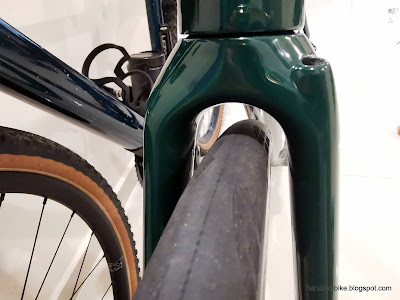While in the process of building the Focus Paralane, I took the chance to compare the geometry with that of the Cervelo Aspero.
These bikes serve quite different purposes for me, although to the untrained eye, they may look very similar. In fact, they are both green in colour, but otherwise, they are quite different bikes.
Comparing the Cervelo Aspero gravel bike with the Focus Paralane commuting bike
Before comparing anything else, I aligned both bikes at the bottom bracket center, as this will serve as the datum for other geometry comparisons.
Focus Paralane has a BB to ground distance of about 270 mm, a little higher than the Cervelo Aspero at 261 mm.
Focus Paralane has a sloping top tube, resulting in a head tube that is much higher (150 mm vs 107 mm).
This also means a higher standover height on the Paralane which is about 780 mm, compared to 732 mm on the Aspero.
Aspero has a relatively short chainstay length of 420 mm, while the Paralane has an even shorter chainstay length of 415 mm.
Front center distance from BB to front axle is 587 mm, while the Aspero is 592 mm with the Trail Mixer in the rearward position.
Overall, the wheelbase of the Paralane is 990 mm, which is road-bike like, while the Aspero has a slightly longer wheelbase of 1000 mm for a bit more stability. These are small differences, but might have an effect on the overall bike handling.
Moving on, let's check out the geometry around the handlebar area. I used the Aspero as a reference, to determine how much of the steerer tube I should cut from the Paralane.
I first tried the 90 mm BBB stem that came with the Paralane.
However, this will end up putting the handlebar too far forward, as the Paralane already has a pretty long frame reach of 379 mm vs 369 mm on the Aspero.
I then used the 80 mm PRO PLT stem, which seems to place the handlebar in a more similar position compared to the Aspero.
Looks misaligned from this angle, as the handlebar is not installed.
With the handlebar installed, the reach is still longer than the Aspero. The length on top of the stem is what needs to be cut from the steerer tube.
Both handlebars are at the same height, but the handlebar is just a bit more forward on the Paralane. This should be OK since I purposely shortened the stem on the Aspero for gravel riding.
Here is how it looks later, with the shifters installed and bar tape wrapped.
The Paralane came with an offset seatpost, which is not ideal for me as I need a zero offset seatpost. However, it is hard to find a suitable replacement for a 25.4 mm diameter seatpost. Some have saddle clamps that are not suitable for carbon saddle rails, while some are not able to accept a Di2 battery inside. Some are very heavy aluminium types with a chunky clamp.
Pushing the saddle all the way to the front, to compensate for the offset seatpost.
Not ideal, but it will have to do for now, until I find a zero offset seatpost.
Saddle on the Paralane is further back, due to the offset seatpost.
Distance from handlebar to saddle sit bone point:
Cervelo Aspero: 64 cm
Fabike C3: 66 cm
Focus Paralane: 65.5 cm
Comparing the outline of the Paralane with the Aspero.
View from the top
The Aspero has very big tire clearance, as it is a gravel bike. However, the Paralane has pretty decent tire clearance as well for a road bike, as it is meant to be an endurance bike.
Good tire clearance around the rear 28 mm wide tire.
Also good tire clearance around the bottom bracket area. Probably can use a tire that is a few millimeters wider.
Good tire clearance around the fork, which is good for putting standard mudguards.
Overall, I used the Aspero as a reference, to set the geometry for the Paralane. It is useful, as otherwise I cannot determine the handlebar position and the amount to cut from the fork steerer tube.






















No comments:
Post a Comment
Every comment is moderated before publishing due to spam bots. If you don't see your comment yet, it is likely that it is currently being reviewed. Thank you for your patience!